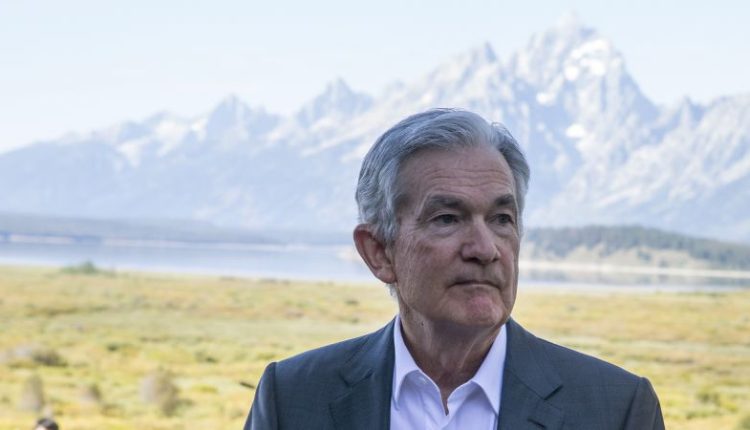What do a mountainside resort and economists have in common? Next to nothing, if it weren’t for an annual invite-only summit the Kansas City Federal Reserve hosts at the Jackson Lake Lodge nestled in a valley by the Teton mountains just outside Jackson Hole, Wyoming.
And it’s that time of year again. For the next three days, top economists from across the globe will rub shoulders with one another and mingle with reporters and investors hungry for clues about the economic outlook. But you won’t need an invite to hear what’s undoubtedly going to be the talk of the valley: Fed Chair Jerome Powell’s keynote address that’s set to take place Friday at 10 am ET.
His speech comes at a pivotal time not just for the US economy but for Fed officials as well.
Last month, the US unemployment rate unexpectedly jumped to 4.3%, its highest level since October 2021. Employers, meanwhile, hired just 114,000 new workers in July, the second-lowest monthly gain since December 2020. The disappointing data sparked some fears that the economy could soon enter a recession — or, even worse, already be in one.
That has subjected the Fed to a considerable amount of criticism for its decision not to cut interest rates at its last meeting, which took place just two days before the July jobs report came out. Now, with a cooling labor market and inflation trailing just a hair above the Fed’s 2% target, the central bank is widely expected to cut rates in September. But some economists are concerned that central bankers waited too long, and that the delay could be exacerbating the weakening of the labor market.
New data the Bureau of Labor Statistics released on Wednesday did little to quell those concerns. Though not finalized yet, the agency’s annual review of employment data suggests there were 818,000 fewer jobs in March of this year than were initially reported.
Because of that, a growing share of investors now believe the Fed could opt for a half-point cut next month rather than the more typical quarter-point cut, according to Fed funds futures data. Additionally, the data has raised the odds that the Fed will lower rates more than once this year.
Where does Powell stand in this discourse? We could find out on Friday.
Last year, investors interpreted Powell’s Jackson Hole remarks as a sign that the Fed was done hiking rates, despite Powell saying it could still happen. Markets rallied, with the Dow adding 241 points, or 0.7%. Their interpretation ended up being correct — the Fed hasn’t raised rates since last July.
Powell’s 2022 keynote Jackson Hole address got the exact opposite reaction. It set in motion that officials were going to be unapologetic in their fight against inflation, even if it meant inflicting “pain,” as Powell said, on households and businesses. The Dow Jones Industrial Average, S&P 500 and Nasdaq Composite all closed at least 3% lower that day.
Two three-quarter-point rate hikes followed at the Fed’s subsequent meetings after Jackson Hole that year.
Powell isn’t the only US central banker who has used Jackson Hole as an opportunity to preview monetary policy changes.
For instance, in 2010, then-Fed Chair Ben Bernanke signaled that the central bank was likely to ease financial conditions further as the economy recovered from the Great Recession, saying that “policy options are available to provide additional stimulus.” Months after Bernanke’s Jackson Hole speech, he unveiled a whole new phase of bond purchasing in an effort to bring interest rates down to juice the economy after the financial crisis. That action has now become known as QE2, short for quantitative easing.
Then, in his 2012 Jackson Hole address, Bernanke said that labor market stagnation was a “grave concern.” Markets initially dropped after Bernanke’s remarks, but ended the day higher. Shortly after the Jackson Hole meeting, the Fed launched QE3.
In 2016, then-Fed Chair Janet Yellen, the current Treasury secretary, used her Jackson Hole address to prepare markets for more rate hikes, saying that she believed “the case for an increase in the federal funds rate has strengthened in recent months.” Starting in December 2016, the Fed hiked rates approximately every three meetings until 2018.
Economists expect Powell’s address to strike a dovish tone: That is, when central bankers favor efforts like lowering interest rates to stimulate the economy to counteract weakness, instead of focusing on getting inflation lower.
The question is just how dovish Powell will get.
The mere mention of Wednesday’s substantial downward payroll data revisions would signal that a half-point cut could be on the table at September’s meeting, Citigroup economists said in a note Wednesday. Economists from the bank are forecasting half-point cuts at both the September and November meeting.
Goldman Sachs economists expect Powell to express “a bit more confidence in the inflation outlook” and possibly say that officials are paying close attention to labor market data while noting the Fed is “well positioned to support the economy if necessary.”
Comments like those would solidify a cut in September but would still leave open the question of the rate cut size until the August jobs report, due September 6, Goldman Sachs economists said in a note earlier this week.
While they aren’t expecting Powell to say anything that implies the current rate level“is inappropriate in light of the progress made on inflation,” if he did, that would raise the odds of a larger September cut and fuel the case for more cuts at future meetings.
Powell, though, won’t be the only Fed official at Jackson Hole. Plenty of other key figures from the central bank, including Kansas City Fed President Jeffrey Schmid and Atlanta’s Raphael Bostic, will be in attendance, partaking in impromptu media interviews, which could provide more color on the economic outlook than Powell.
Read the full article here

